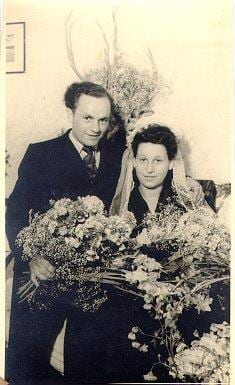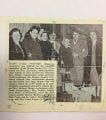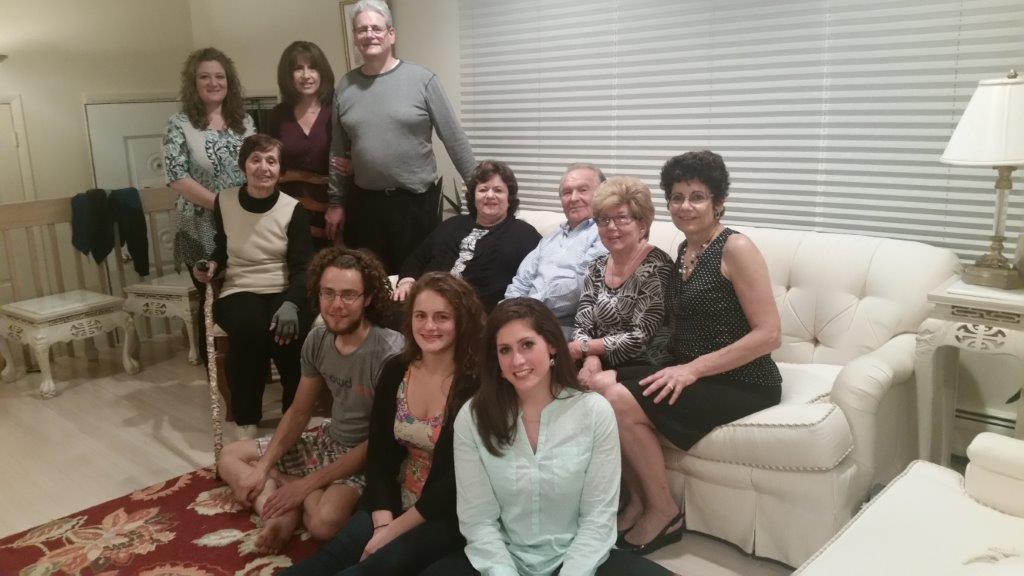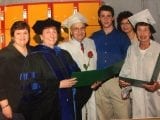- Local Survivor registry
- SARAH C. SCHWARZBERG
- Local Survivor registry
- SARAH C. SCHWARZBERG
Survivor Profile

SARAH
C.
SCHWARZBERG
(1926 - 2017)
PRE-WAR NAME:
SARAH (CEDARBOJM) CEDARBAUM
SARAH (CEDARBOJM) CEDARBAUM
PLACE OF BIRTH:
REJOWIEC, POLAND
REJOWIEC, POLAND
DATE OF BIRTH:
AUGUST 12, 1926
AUGUST 12, 1926
LOCATION(s) BEFORE THE WAR:
REJOWIEC, POLAND
REJOWIEC, POLAND
LOCATION(s) DURING THE WAR:
REJOWIEC GHETTO; MAJDANEK AND AUSCHWITZ CONCENTRATION CAMPS, POLAND
REJOWIEC GHETTO; MAJDANEK AND AUSCHWITZ CONCENTRATION CAMPS, POLAND
STATUS:
SURVIVOR
SURVIVOR
RELATED PERSON(S):
DAVID ISRAEL SCHWARZBERG - Spouse (Deceased),
PEPPY MARGOLIS - Daughter,
ROBERT SCHWARZBERG - Son,
ESTHER SCHWARZBERG SHULMAN - Daughter,
LISA MARGOLIS - Granddaughter
-
BIOGRAPHY BY NANCY GORRELL
Sarah Cedarbojm was born and raised in Rejowiec, Poland, just outside of Lublin. She had a grandmother she was very close to. She had two older brothers, 17 and 18 years of age. Her brothers were tailors working with their grandfather. Sarah’s grandfather was a handsome and well-respected man in Rejowiec. In the summers the family would go on vacation together. Her father made a decent living and they lived in a house. Sarah celebrated Jewish holidays in her home and the town had a synagogue. She enjoyed holidays and visiting family in neighboring Lublin and Chelm.
It was Passover when the Nazis came for them. Sarah was 12 years old when she was taken to the Rejowiec ghetto. Her grandfather had a Polish woman working for him, and he gave the woman jewelry and money to save Sarah. This Polish woman agreed to hide Sarah, and she put her in a haystack for one day, and then took her to the ghetto to get money from the Nazis. Sarah ended up in the ghetto with the rest of her family. This was in 1939. Eventually, they were sent to Majdanek, where Sarah saw her mother being taken to the gas chamber. She didn’t know what happened to her father or her brothers.
Sarah spent the entire war in Majdanek and then Auschwitz. She never talked about her experience, so the family does not know exactly when she went to Auschwitz. But Sarah was definitely in the ghetto and then two death camps. She was liberated by the Russians while on a death march. The only story she ever told the her daughter, Peppy, was that the last week before liberation, one of her brothers got past the killer dogs and found her in her barracks. He was only 80 pounds at the time. Sarah told him to hold out and she gave him a piece of moldy bread that she saved. He told her that she had to live to tell the story. Her brother did not survive and now in 2017, Sarah at 91 has Alzheimer’s disease and cannot tell the story.
Like her future spouse, after liberation she ended up in a Displaced Persons camp in Zeilsheim, Germany, in the American occupied zone. There she met her future husband, David Schwarzberg, and they married at the end of October 1945. Sarah gave birth to their first child, Peppy, in the DP camp on July 19, 1946. They waited four more years before they could emigrate—two years in Zeilsheim, and two years across from the train station in Frankfurt.
Sarah, David and Peppy came to the United States at the end of April 1950 by plane. They were the first group to go by plane. Their flight was arranged through the Jewish Community of Westwood, New Jersey that sponsored them, and also HIAS; they settled in Westwood. Westwood was like a little island within an anti-Semitic area. Sarah was pregnant with her second child at the time. Robert was born on May 3, 1950. After her children all grew up, Sarah and David moved to Rivervale, New Jersey on Westwood Avenue.
Editor’s Note:
Refer to Historical Notes below for Rejowiec Ghetto and Majdanek Concentration Camp
-
SURVIVOR INTERVIEW:
SARAH CEDARBAUM SCHWARZBERG INTERVIEW WITH PEPPY MARGOLIS, DAUGHTER
Location: Raritan Valley Community College, Branchburg, New Jersey
Date: May 22, 2017
Interviewer: Nancy Gorrell
Q: Describe your mother’s background.
My mother, Sarah Cedarbojm was born in Rejowiec, Poland in August 1926 and grew up there until she was 12 years old when she was taken to the Rejowiec ghetto. She had a grandmother she was close to. She talked about her grandmother. They had to leave her grandmother behind. She had two older brothers, 17 and 18 years old. They were tailors with my grandfather. My grandfather was a handsome and well-respected man in town. Rejowiec was bigger than my father’s town; not a shtetl. In the summers they would go on vacation with the family. They had a better life than my father. They lived in a house and they had a synagogue in the town.Q: What was religious life in Rejowiec like pre-war?
My mother talked about going to a synagogue and having holidays in the home with all her family. She talked about holidays and visiting family in Lublin and Chelm.Q: What happened to your mother’s family when Hitler invaded Poland?
It was Passover when the Nazis came for them. Passover is a difficult holiday for my mother because she remembers the soup and food cooking on the stove. My grandfather had a Polish woman working for him, and he gave her jewelry and money to save my mother. This Polish woman agreed to hide my mother, and she put her in a haystack for one day, and then took her to the ghetto to get money from the Nazis, so my mother ended up in the ghetto with the rest of the family. This was 1939. They stayed in the ghetto. Eventually, they were sent to Majdanek, where she saw her mother being taken to the gas chamber. My grandmother was killed in Majdanek. My mother didn’t know what happened to her father or brothers.Q: What did your mother ever tell you about her experiences in Majdanek and Auschwitz?
She was in two death camps for the entire time—Majdanek and Auschwitz. She never talked about her experience. She eventually went to Auschwitz. I don’t know when. I think she was two years in each place. But she was in the ghetto and then two death camps for the whole time.Q: Did she speak about liberation?
She was liberated by the Russians while on a death march. The only thing she ever told me was the last week before liberation, one of her brothers found her in the barracks. To this day she didn’t know how he got past the killer dogs. He was 6’ 2” and he was only 80 pounds. She asked him to hold out. She gave him a small piece of moldy bread she saved. He told her she had to live to tell the story. How did he walk through the camp to see my mother? She told me she would tell her story on her deathbed. But I’m sure in Auschwitz there are medical records. Now she’s 91 and has Alzheimer’s disease, so she relives her time in the Holocaust but can’t talk about it.Q: What happened to your mother after liberation?
Like my father, she went to Frankfurt Am Main and was placed in a Displaced Persons camp, in Zeilsheim, Germany (12 miles west of Frankfurt) in the American occupied zone. She met my father in the DP camp, and they married at the end of October 1945, and I was born in the DP camp on July 19, 1946. They waited four more years before they could emigrate—two years in Zeilsheim, and two years across from the train station in Frankfurt.Q: What was emigrating from Germany to America like for your family?
My mother, father and I came to the US, at the end of April 1950 by plane. We were the first group to go by plane. It was a cargo plane. We did not go through Ellis Island. We were sick the whole time on that plane. This was arranged through the Jewish Community of Westwood, New Jersey that sponsored us, and also HIAS; they settled us in Westwood. Westwood was like a little island within an anti-Semitic area. I was almost five years old. My mother was pregnant with my brother, Robert at the time. Robert was born on May 3, 1950. We did not know about living family in America. We did locate family in New York: a distant cousin of my father, Joe Siegel, and my mother’s aunt, Lilly Wessley. We were very lucky, but we were very isolated because there no other family members close by, and we couldn’t speak the language. After we all grew up, my parents moved to Rivervale, New Jersey on Westwood Avenue. My parents loved living on something called “Westwood.”Editor’s Note:
Refer to Peppy Margolis in Voices of the Descendants
-
HISTORICAL NOTES:
Rejowiec Ghetto and Majdanek Concentration Camp
Rejowiec is a town in the Lublin district. The Germans occupied the town in September, 1939. A ghetto was established in 1941 with an average population of about 3,000 persons. Jews from Lublin, Cracow and Czechoslovakia passed through the ghetto. The ghetto was liquidated in 1943, with the remaining residents sent to Auschwitz and Majdanek.
The Majdanek concentration camp is situated in a major urban area, four kilometers from the city center of Lublin, and can be easily reached by trolley car. The location of the Majdanek camp is in an area of rolling terrain and can be seen from all sides; it could not be more public or accessible. It is located in an entirely open area with no trees around it to hide the activities inside the camp, as at Dachau. There was no security zone established around the Majdanek camp, as at Birkenau, and there is no natural protection, such as a river or a forest, as at Treblinka. Besides being bounded on the north by a busy main road, the camp was bounded on the south by two small villages named Abramowic and Dziesiata. People driving past the camp, while it was in operation, had a completely unobstructed view, being able to see the tall brick chimney of the crematorium wafting smoke from the top of a slope not far away, and the gas chamber building which is very close to the street.
-
Sources and Credits:
Credits:
SSBJCC Survivor Registry Interview with Peppy Margolis, May 22, 2017, Interviewer: Nancy Gorrell; Biography by Nancy Gorrell. Digital historic and family photographs and documents donated by Peppy Margolis.









